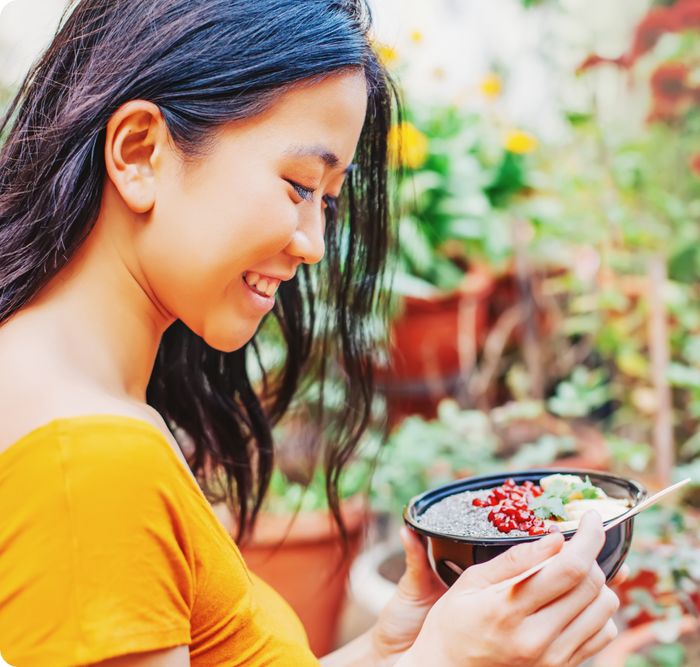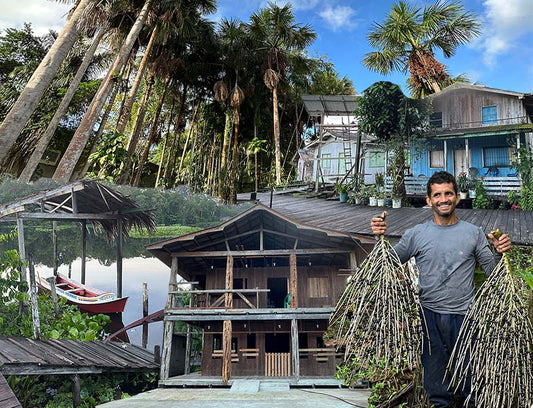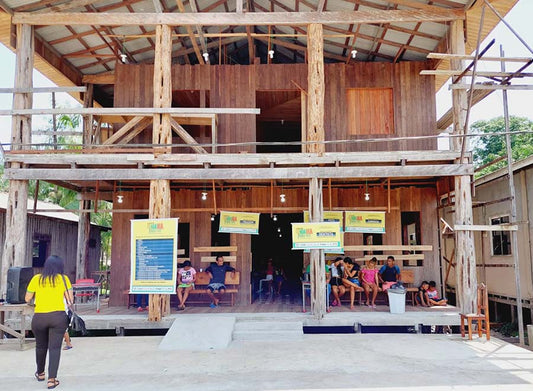The Amazon Rainforest is home to an astonishing array of trees, after all it is the most biodiverse place on Earth. Each plays a crucial role in the ecosystem, and deforestation and climate change pose. significant threat to these tree species.
In 2020, we initiated a biodiversity study focused on our Certified Fair Trade harvesting areas to measure and document the wildlife and species that exist there. We gained a wealth of knowledge...intrigued to learn more about the remarkable tree species that were discovered in this research?
The Amazon Rainforest
The Amazon’s awe-inspiring ecosystem is not only a haven for countless species but also a vital player in the global carbon cycle. It encompasses 1.6 billion acres and stretches across 8 countries and 1 territory and contains 10% of the world’s biodiversity. This landscape’s existence hangs in the balance, with more than 20% of the region already succumbing to several factors, including the devastating effects of slash-and-burn agriculture as one of the largest contributors.
One organization that stands in the face of this threat is the Rainforest Trust Foundation, which strives to conserve and protect life within the Amazon Rainforest. Their Conservation Action Fund helps to establish public and private nature reserves managed by local conservation partners.
Biodiversity Study on SAMBAZON’s Certified Harvesting Areas
In pursuit of a deeper understanding of biodiversity within our harvesting areas, we funded a research grant worth $35,000 USD. This independent study, led by esteemed scientists at UC Berkeley alongside a team of researchers* from the United States and Brazil, aimed to analyze the impact of harvesters and our Fair-Trade Certified practices on the Amazon Rainforest ecosystem.
Under the guidance of Dr. Gabriel Damasco, Ph.D., the Biodiversity study, titled “Certification of Açaí agroforestry increase the conservation potential of the Amazonian tree flora,” was published in January 2022, and focused on the tree species of the region. First, it highlighted adverse environmental effects of unregulated extraction in the Amazon, emphasizing the importance of certified sustainable agroforestry in reducing forest exploitation.
The study discovered that certified managed forests harbor an average of 50% or more tree species, providing greater protection and habitat for various plants and animals. In addition, Açaí palms function as pioneer species that facilitate the growth and establishment of tree species that become old-growth trees, which dominate mature forest areas and are important to protecting habitats and storing carbon. The certified harvesting sites demonstrated dense populations of threatened species, further adding to the value that sustainable practices provide to the precious biodiversity of the Amazon Rainforest.
Findings on Tree Species in our Certified Harvesting Areas
Following Organic and Fair-Trade harvesting practices and keeping the forests mostly intact may add additional value to the forest beyond the delicious Açaí. There were 131 species distributed across 34 botanical families recorded by the researchers, including one species that is threatened with extinction (Virola surinamensis) according to the International Union for Conservation of Nature (IUCN).
The study also discovered that some areas of moderately managed Açaí, in which few trees were cut, showed greater species richness than areas that were not managed. This showed that there is the potential that Fair Trade certified Açaí management represents an efficient way to guarantee conservation of native trees in harvest areas.

The graph above shows the relative importance of the top ten species based on their abundance, frequency, and basal dominance (tree density). Virola surinamensis, classified as a threatened species according to the IUCN, is the most dominant tree in certified harvest areas.
Several tree species found in abundance in harvesting areas are described below. The Amazon locals prize these plants, and our harvesting community has used the forest as a great resource for home remedies for generations. While SAMBAZON does not endorse or promote these properties or claims, we are happy to share what we have learned from our local communities.
As Dr. Damasco explained, “it is simply intriguing to learn about the reality and life routine of Açaí producers. These local people know their forests very well. This kind of empirical knowledge is not conceived at universities or schools. If these producers are oriented in the right direction, the conservation of the Amazon could be much more effective.”
The Uses of Tree Species found in our Certified Harvesting Areas
Andiroba
Andiroba, or Carapa guianensis, is a species of tree in the Meliaceae family, which includes trees like mahogany and cedar. It is a large evergreen tree that can reach heights of up to 130 feet with a straight, cylindrical trunk. It produces oil that is used as an effective mosquito repellent in South America as it can be used topically for inflammation and itching, and it is also used by locals internally to treat malaria, stomach aches, and hacking cough.
Mututi
Pterocarpus santalinoides is a tree species in the legume family, and ranges from 32-49 feet. Its flowers are orange and yellow, and it helps protect other plants and enriches the soil. The roasted seeds are edible, and the bark, roots and leaves are used by the harvesting community to treat bronchial complaints, stomach-aches and sleeping sickness.
Pracaxi
Pracaxi, or pentaclethra macroloba is an evergreen tree that can reach up to 130 feet with a straight trunk and a dense crown of foliage. The sap is used to cleanse sores, the bark is antiseptic, emetic and styptic, the leaves are used to treat chickenpox and measles, and the seed is used to make plasters for treating itches. This trees foliage also provides shade and habitat for other plant and animal species, its roots prevent soil erosion and contributes to stability in the surrounding environment.
Ubussu
Manicaria saccifera, or ubussu, is a tall and slender palm tree species that can reach up to 82 feet. This tree is really interesting because of two distinctive characteristics: it’s covered in dense, sharp spines to protect itself from herbivores, and large, stilt-like roots that extend from the base of the tree and allows it to “walk” or reposition itself to compete for sunlight in a crowded rainforest. It’s large leaves are used as thatch and sails as they are firm and rigid to form durable house covers.
Yellow Mombin
Yellow mombin, or spondias mombin, is a tropical fruit species and ranges from 33 to 49 feet. It’s tasty yellow or orange fruit can be eaten raw with its sweet yet tart taste, or cooked with sugar, and made into jam, ice cream, juice, or pickled. The bark and flowers are used locally in tea to help digestive tract ailments, lower back pain, sore throats.
Palmeira Murumura
The Palmeira Murumura, or astrocaryum murumuru, is a dominant and large palm tree that produces a fruit that is aromatic with a melon-like sweet-acidic flavor. The kernel produces a rich extract used by the beauty industry as an ingredient in shampoos, conditioner, and moisturizing skin care products. Locals also prepare a paste from the fruit that they use to treat sprains and fractures.
White Ucuba
Virola surinamensis or the White Ucuba is an Endangered evergreen tree that grows up to 130 feet. The stem is used to relieve coughs, as a disinfectant, and is used to soften or soothe skin. The bark is used in mouthwash to treat abscessed teeth. The tree also provides habitat and food for various animals, including birds, insects, and mammals.
Conservation efforts and responsible management are essential to protect the long-term survival of these valuable tree species. The results of this study show that sustainable and certified harvesting of Açaí can provide significant benefits such as conservation of intact forests that harbor high biodiversity, and prevention of deforestation that exacerbates global climate change.
By fostering a higher diversity of tree species, facilitating the growth of older and larger trees, and creating favorable habitats for endangered animals, certified managed forests showcase the incredible conservation benefits they offer. These findings help to validate our commitment to sustainable practices and also highlight the significant role that responsible agroforestry can play in preserving the precious biodiversity of the Amazon Rainforest.
*Full List of Authors: Gabriel Damasco, Ph.D., Mandy Anhalt, M.S., Ricardo O. Perdiz, Ph.D., Florian Wittmann, Ph.D., Rafael L. de Assis, Ph.D., Jochen Schöngart, Ph.D., Maria T. F. Piedade, Ph.D., Christine D. Bacon, Ph.D., Alexandre Antonelli, Ph.D., & Paul V. A. Fine, PhD
Sources
Fern, Ken. “Carapa guianensis.” Useful Tropical Plants Database, 2022-07-20, 2022-07-20. https://tropical.theferns.info/viewtropical.php?id=Carapa+guianensis
Fern, Ken. “Pterocarpus santalinoides.” Useful Tropical Plants Database, 2022-07-20. https://tropical.theferns.info/viewtropical.php?id=Pterocarpus+santalinoides
Fern, Ken. “Pentaclethra macroloba.” Useful Tropical Plants Database, 2022-07-20, https://tropical.theferns.info/viewtropical.php?id=Pentaclethra+macroloba
Fern, Ken. “Manicaria saccifera.” Useful Tropical Plants Database, 2022-07-20, https://tropical.theferns.info/viewtropical.php?id=Manicaria+saccifera
Fern, Ken. “Spondias mombin.” Useful Tropical Plants Database, 2022-07-20, https://tropical.theferns.info/viewtropical.php?id=Spondias+mombin
Fern, Ken. “Astrocaryum murumuru.” Useful Tropical Plants Database, 2022-07-20, https://tropical.theferns.info/viewtropical.php?id=Astrocaryum+murumuru
Fern, Ken. “Virola surinamensis.” Useful Tropical Plants Database, 2022-07-20, https://tropical.theferns.info/viewtropical.php?id=Virola+surinamensis








Comments
(0 Comments)Please note, comments need to be approved before they are published.